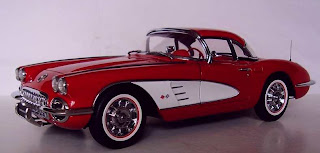Thursday, February 14, 2013
The Chevrolet Corvette (C1)
The Chevrolet Corvette (C1) is the first generation of the sports car by the Chevrolet division of General Motors introduced late in the 1953 model year and produced through 1962. It is commonly referred to as the "solid-axle" generation, as the independent rear suspension did not appear until the 1963 Sting Ray. The Corvette was rushed into production for its debut model year to capitalize on the enthusiastic public reaction to the concept vehicle, but expectations for the new model were largely unfulfilled.
Reviews were mixed and sales fell far short of expectations through the car's early years. The program was nearly canceled, but Chevrolet would ultimately stay the course and Harley Earl and company would transform the Corvette into a true world-class sports car.
In 1927 General Motors hired designer Harley Earl who loved sports cars. GIs returning after serving overseas in the years following World War II were bringing home MGs, Jaguars, Alfa Romeos, and the like. In 1951, Nash Motors began selling an expensive two-seat sports car, the Nash-Healey, that was made in partnership with the Italian designer Pinin Farina and British auto engineer Donald Healey, but there were few moderate-priced models. Earl convinced GM that they needed to build a two-seat sports car, and with his Special Projects crew began working on the new car, "Project Opel" in late 1951. The result was the hand-built, EX-122 pre-production Corvette prototype, which was first shown to the public at the 1953 GM Motorama at the Waldorf-Astoria in New York City on January 17, 1953. Production began six months later. The car is now located at the Kerbeck Corvette museum in Atlantic City and is believed to be the oldest Corvette in existence. wikipedia.org
During the last half of 1953, 300 Corvettes were to large degree hand-built on a makeshift assembly line that was installed in an old truck plant in Flint, Michigan while a factory was being prepped for a full-scale 1954 production run. The outer body was made out of then-revolutionary fiberglass material, selected in part because of quotas, left over from the war, limited the availability of steel. A 55 degree racked windshield was made of safety glass, while the licience plate holder was set back in the trunk, covered with a plastic window Underneath the new body material were standard components from Chevrolet's regular car line, including the "Blue Flame" inline six-cylinder engine, two-speed Powerglide automatic transmission, and drum brakes. The engine's output was increased however from a triple-carburetor system exclusive to the Corvette, but performance of the car was decidedly "lackluster". Compared to the British and Italian sports cars of the day, the Corvette lacked a manual transmission and required more effort to bring to a stop, but like their British competition, such as Morgan, was not fitted with roll-up windows; this would have to wait until sometime in the 1956 model year.A Paxton centrifugal supercharger became available in 1954 as a dealer-installed option, greatly improving the Corvette's straight-line performance, but sales continued to decline.
The Chevrolet division was GM's entry-level marque. Managers at GM were seriously considering shelving the project,[15] leaving the Corvette to be little more than a footnote in automotive history, and would have done so if not for three important events. The first was the 1955 introduction of Chevrolet's first V8 engine since 1919. Late in the model year, the new 195 hp (145 kW) 265 small-block became available with a three-speed manual transmission, coupled to a 3.55:1 axle ratio, the only one offered.The engine was fitted with a single 2366S WCFB four-barrel (four-choke) Carter carburetor. The combination turned the "rather anemic Corvette into a credible if not outstanding performer".
The second was the influence of a Russian émigré in GM's engineering department, Zora Arkus-Duntov. The third factor in the Corvette's survival was Ford's introduction of the 1955 two-seat Thunderbird, which was billed as a "personal luxury car", not a sports car. Even so, the Ford-Chevrolet rivalry in those days demanded GM not appear to back down from the challenge. The original concept for the Corvette emblem incorporated an American flag into the design, but was changed well before production since associating the flag with a product was frowned upon.
Die Chevrolet Corvette (C1) ist die erste Generation des Sportwagens von der Chevrolet Division von General Motors in den späten 1953 Modell des Jahres und produzierte bis 1962. Es wird allgemein als "solid-Achs-Generation" bezeichnet, da die Einzelradaufhängung hinten nicht bis 1963 Sting Ray erscheinen. Die Corvette wurde in die Produktion für seine Debüt-Modell des Jahres stürzte auf die begeisterte Reaktion der Öffentlichkeit auf die Konzept-Fahrzeug zu nutzen, aber die Erwartungen für das neue Modell weitgehend unerfüllt.
Chevrolet Corvette (C1) является первое поколение спортивного автомобиля путем разделения Chevrolet от General Motors представила в конце 1953 модельного года и производятся по 1962 год. Это обычно упоминается как "твердое-ось" поколения, а независимая задняя подвеска не появлялись до 1963 года Sting Ray.Corvette был доставлен в производство для своего модельного года Дебют заработать на восторженные реакции общественности на концепцию автомобиля, но надежды на новую модель в значительной степени нереализованным.
وشفروليه كورفيت (C1) هو الجيل الأول من السيارات الرياضية من قبل شعبة شيفروليه من جنرال موتورز قدم في وقت متأخر من نموذج عام 1953 والمنتجة من خلال 1962. ويشار إلى أنه في الجيل "الصلبة المحور"، كما تعليق مستقل خلفي لم تظهر حتى ستينغ راي 1963. ونقل كورفيت في الإنتاج لاول مرة في نموذج عام للاستفادة من رد فعل الجمهور متحمسا لمفهوم السيارة، ولكن التوقعات كانت النموذج الجديد لم تتحقق إلى حد كبير.
Subscribe to:
Post Comments (Atom)
















No comments:
Post a Comment